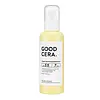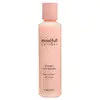What's inside
What's inside
 Key Ingredients
Key Ingredients

 Benefits
Benefits

 Concerns
Concerns

 Ingredients Side-by-side
Ingredients Side-by-side

Water
Skin ConditioningHydrogenated Polyisobutene
EmollientCyclopentasiloxane
EmollientBetaine
HumectantGlycerin
HumectantButylene Glycol
HumectantNeopentyl Glycol Dicaprate
Emollient1,2-Hexanediol
Skin ConditioningC14-22 Alcohols
Emulsion StabilisingHydrogenated Lecithin
EmulsifyingDimethicone
EmollientCetearyl Alcohol
EmollientCaprylic/Capric Triglyceride
MaskingC12-20 Alkyl Glucoside
EmulsifyingAmmonium Acryloyldimethyltaurate/Vp Copolymer
Batyl Alcohol
EmollientStearic Acid
CleansingCamellia Oleifera Seed Oil
Skin ConditioningLecithin
EmollientTocopheryl Acetate
AntioxidantEthylhexylglycerin
Skin ConditioningXanthan Gum
EmulsifyingDisodium EDTA
Glyceryl Stearate
EmollientSodium Hyaluronate
HumectantPolyquaternium-51
Skin ConditioningNiacinamide
SmoothingGlycerylamidoethyl Methacrylate/Stearyl Methacrylate Copolymer
HumectantEthylhexyl Isononanoate
EmollientDipropylene Glycol
HumectantAlteromonas Ferment Extract
Skin ConditioningPropylene Glycol
HumectantPhytosteryl/Isostearyl/Cetyl/Stearyl/Behenyl Dimer Dilinoleate
Skin ConditioningBacillus Ferment
Skin ConditioningLavandula Angustifolia Oil
MaskingCeramide NP
Skin ConditioningHydroxypropyl Bispalmitamide Mea
EmollientGlycine Soja Sterols
EmollientYeast Extract
Skin ConditioningMeadowfoam Estolide
Skin ConditioningGlycoproteins
Skin ConditioningGlyceryl Polymethacrylate
Cymbopogon Citratus Leaf Oil
MaskingCitrus Grandis Fruit/Peel Water
HumectantAleuritic Acid
Skin ConditioningTheobroma Cacao Seed Extract
AntioxidantPelargonium Graveolens Oil
MaskingCetearyl Glucoside
EmulsifyingHydrogenated Polydecene
EmollientCitrus Aurantium Dulcis Peel Oil
MaskingSantalum Album Oil
MaskingPogostemon Cablin Leaf Oil
MaskingChamomilla Recutita Flower Oil
MaskingGlycosphingolipids
EmollientGlyceryl Citrate/Lactate/Linoleate/Oleate
EmulsifyingCeteareth-20
CleansingButyrospermum Parkii Butter
Skin ConditioningCeramide AP
Skin ConditioningCeramide EOP
Skin ConditioningWater, Hydrogenated Polyisobutene, Cyclopentasiloxane, Betaine, Glycerin, Butylene Glycol, Neopentyl Glycol Dicaprate, 1,2-Hexanediol, C14-22 Alcohols, Hydrogenated Lecithin, Dimethicone, Cetearyl Alcohol, Caprylic/Capric Triglyceride, C12-20 Alkyl Glucoside, Ammonium Acryloyldimethyltaurate/Vp Copolymer, Batyl Alcohol, Stearic Acid, Camellia Oleifera Seed Oil, Lecithin, Tocopheryl Acetate, Ethylhexylglycerin, Xanthan Gum, Disodium EDTA, Glyceryl Stearate, Sodium Hyaluronate, Polyquaternium-51, Niacinamide, Glycerylamidoethyl Methacrylate/Stearyl Methacrylate Copolymer, Ethylhexyl Isononanoate, Dipropylene Glycol, Alteromonas Ferment Extract, Propylene Glycol, Phytosteryl/Isostearyl/Cetyl/Stearyl/Behenyl Dimer Dilinoleate, Bacillus Ferment, Lavandula Angustifolia Oil, Ceramide NP, Hydroxypropyl Bispalmitamide Mea, Glycine Soja Sterols, Yeast Extract, Meadowfoam Estolide, Glycoproteins, Glyceryl Polymethacrylate, Cymbopogon Citratus Leaf Oil, Citrus Grandis Fruit/Peel Water, Aleuritic Acid, Theobroma Cacao Seed Extract, Pelargonium Graveolens Oil, Cetearyl Glucoside, Hydrogenated Polydecene, Citrus Aurantium Dulcis Peel Oil, Santalum Album Oil, Pogostemon Cablin Leaf Oil, Chamomilla Recutita Flower Oil, Glycosphingolipids, Glyceryl Citrate/Lactate/Linoleate/Oleate, Ceteareth-20, Butyrospermum Parkii Butter, Ceramide AP, Ceramide EOP
Water
Skin ConditioningHydrolyzed Collagen
EmollientGlycerin
HumectantPropanediol
SolventPentaerythrityl Tetraethylhexanoate
EmollientMethyl Trimethicone
Skin ConditioningHydrogenated Poly(C6-14 Olefin)
Emollient1,2-Hexanediol
Skin ConditioningCetyl Ethylhexanoate
EmollientButylene Glycol
HumectantC14-22 Alcohols
Emulsion StabilisingGlyceryl Stearate Citrate
EmollientHydroxyethyl Acrylate/Sodium Acryloyldimethyl Taurate Copolymer
Emulsion StabilisingArachidyl Alcohol
EmollientStearic Acid
CleansingGlyceryl Stearate
EmollientButyrospermum Parkii Butter
Skin ConditioningPalmitic Acid
EmollientCarbomer
Emulsion StabilisingXanthan Gum
EmulsifyingBehenyl Alcohol
EmollientGlyceryl Caprylate
EmollientTromethamine
BufferingC12-20 Alkyl Glucoside
EmulsifyingParfum
MaskingDisodium EDTA
Ethylhexylglycerin
Skin ConditioningArachidyl Glucoside
EmulsifyingSorbitan Isostearate
EmulsifyingHydrolyzed Lupine Protein
Skin ConditioningMyristic Acid
CleansingLauric Acid
CleansingTocopherol
AntioxidantWater, Hydrolyzed Collagen, Glycerin, Propanediol, Pentaerythrityl Tetraethylhexanoate, Methyl Trimethicone, Hydrogenated Poly(C6-14 Olefin), 1,2-Hexanediol, Cetyl Ethylhexanoate, Butylene Glycol, C14-22 Alcohols, Glyceryl Stearate Citrate, Hydroxyethyl Acrylate/Sodium Acryloyldimethyl Taurate Copolymer, Arachidyl Alcohol, Stearic Acid, Glyceryl Stearate, Butyrospermum Parkii Butter, Palmitic Acid, Carbomer, Xanthan Gum, Behenyl Alcohol, Glyceryl Caprylate, Tromethamine, C12-20 Alkyl Glucoside, Parfum, Disodium EDTA, Ethylhexylglycerin, Arachidyl Glucoside, Sorbitan Isostearate, Hydrolyzed Lupine Protein, Myristic Acid, Lauric Acid, Tocopherol
Ingredients Explained
These ingredients are found in both products.
Ingredients higher up in an ingredient list are typically present in a larger amount.
1,2-Hexanediol is a synthetic liquid and another multi-functional powerhouse.
It is a:
- Humectant, drawing moisture into the skin
- Emollient, helping to soften skin
- Solvent, dispersing and stabilizing formulas
- Preservative booster, enhancing the antimicrobial activity of other preservatives
Butylene Glycol (or BG) is used within cosmetic products for a few different reasons:
Overall, Butylene Glycol is a safe and well-rounded ingredient that works well with other ingredients.
Though this ingredient works well with most skin types, some people with sensitive skin may experience a reaction such as allergic rashes, closed comedones, or itchiness.
Learn more about Butylene GlycolThis ingredient is also known as shea butter. It is an effective skin hydrator and emollient.
Emollients help soothe and soften your skin. It does this by creating a protective film on your skin. This barrier helps trap moisture and keeps your skin hydrated. Emollients may be effective at treating dry or itchy skin.
Shea butter is rich in antioxidants. Antioxidants help fight free-radicals, or molecules that may harm the body. It is also full of fatty acids including stearic acid and linoleic acid. These acids help replenish the skin and keep skin moisturized.
While Shea Butter has an SPF rating of about 3-4, it is not a sunscreen replacement.
Shea butter may not be fungal acne safe. We recommend speaking with a professional if you have any concerns.
Learn more about Butyrospermum Parkii ButterWe don't have a description for C12-20 Alkyl Glucoside yet.
C14-22 Alcohols is made up of synthetic fatty alcohols. More specifically, these fatty alcohols contain 14 to 22 carbons in the alkyl chain.
Its main purpose is to stabilize products. As an emulsifier, it helps prevent waters and oils from separating.
Disodium EDTA plays a role in making products more stable by aiding other preservatives.
It is a chelating agent, meaning it neutralizes metal ions that may be found in a product.
Disodium EDTA is a salt of edetic acid and is found to be safe in cosmetic ingredients.
Learn more about Disodium EDTAEthylhexylglycerin (we can't pronounce this either) is commonly used as a preservative and skin softener. It is derived from glyceryl.
You might see Ethylhexylglycerin often paired with other preservatives such as phenoxyethanol. Ethylhexylglycerin has been found to increase the effectiveness of these other preservatives.
Glycerin is already naturally found in your skin. It helps moisturize and protect your skin.
A study from 2016 found glycerin to be more effective as a humectant than AHAs and hyaluronic acid.
As a humectant, it helps the skin stay hydrated by pulling moisture to your skin. The low molecular weight of glycerin allows it to pull moisture into the deeper layers of your skin.
Hydrated skin improves your skin barrier; Your skin barrier helps protect against irritants and bacteria.
Glycerin has also been found to have antimicrobial and antiviral properties. Due to these properties, glycerin is often used in wound and burn treatments.
In cosmetics, glycerin is usually derived from plants such as soybean or palm. However, it can also be sourced from animals, such as tallow or animal fat.
This ingredient is organic, colorless, odorless, and non-toxic.
Glycerin is the name for this ingredient in American English. British English uses Glycerol/Glycerine.
Learn more about GlycerinGlyceryl Stearate is a mix of glycerin and stearic acid.
It is used to stabilize the mixing of water and oil ingredients. By preventing these ingredients from separating, it can help elongate shelf life. It can also help thicken the product's texture.
As an emollient, it helps soften skin and supports barrier-replenishing ingredients.
In cosmetics, Glyceryl Stearate is often made from vegetable oils or synthetically produced.
This ingredient may not be fungal-acne safe
Fun fact: The human body also creates Glyceryl Stearate naturally.
Learn more about Glyceryl StearateStearic Acid is a fatty acid. It is an emollient, emulsifier, and texture enhancer.
As an emollient, stearic acid helps soften skin. It aids the skin's protective barrier by preventing water loss. It also provides a gentle cleansing effect without stripping away natural oils.
Stearic acid may also be used to enhance the texture of products. It can add volume and stabilize ingredients such as water and oil. This can help water and oil ingredients from separating.
Sources of stearic acid include animal or vegetable fats/oils such as coconut or shea. It can be naturally found in butter, cocoa butter, shea butter, vegetable fats, and animal tallow.
This ingredient may not be Malassezia folliculitis, or fungal-acne safe.
Learn more about Stearic AcidWater. It's the most common cosmetic ingredient of all. You'll usually see it at the top of ingredient lists, meaning that it makes up the largest part of the product.
So why is it so popular? Water most often acts as a solvent - this means that it helps dissolve other ingredients into the formulation.
You'll also recognize water as that liquid we all need to stay alive. If you see this, drink a glass of water. Stay hydrated!
Learn more about WaterXanthan gum is used as a stabilizer and thickener within cosmetic products. It helps give products a sticky, thick feeling - preventing them from being too runny.
On the technical side of things, xanthan gum is a polysaccharide - a combination consisting of multiple sugar molecules bonded together.
Xanthan gum is a pretty common and great ingredient. It is a natural, non-toxic, non-irritating ingredient that is also commonly used in food products.
Learn more about Xanthan Gum